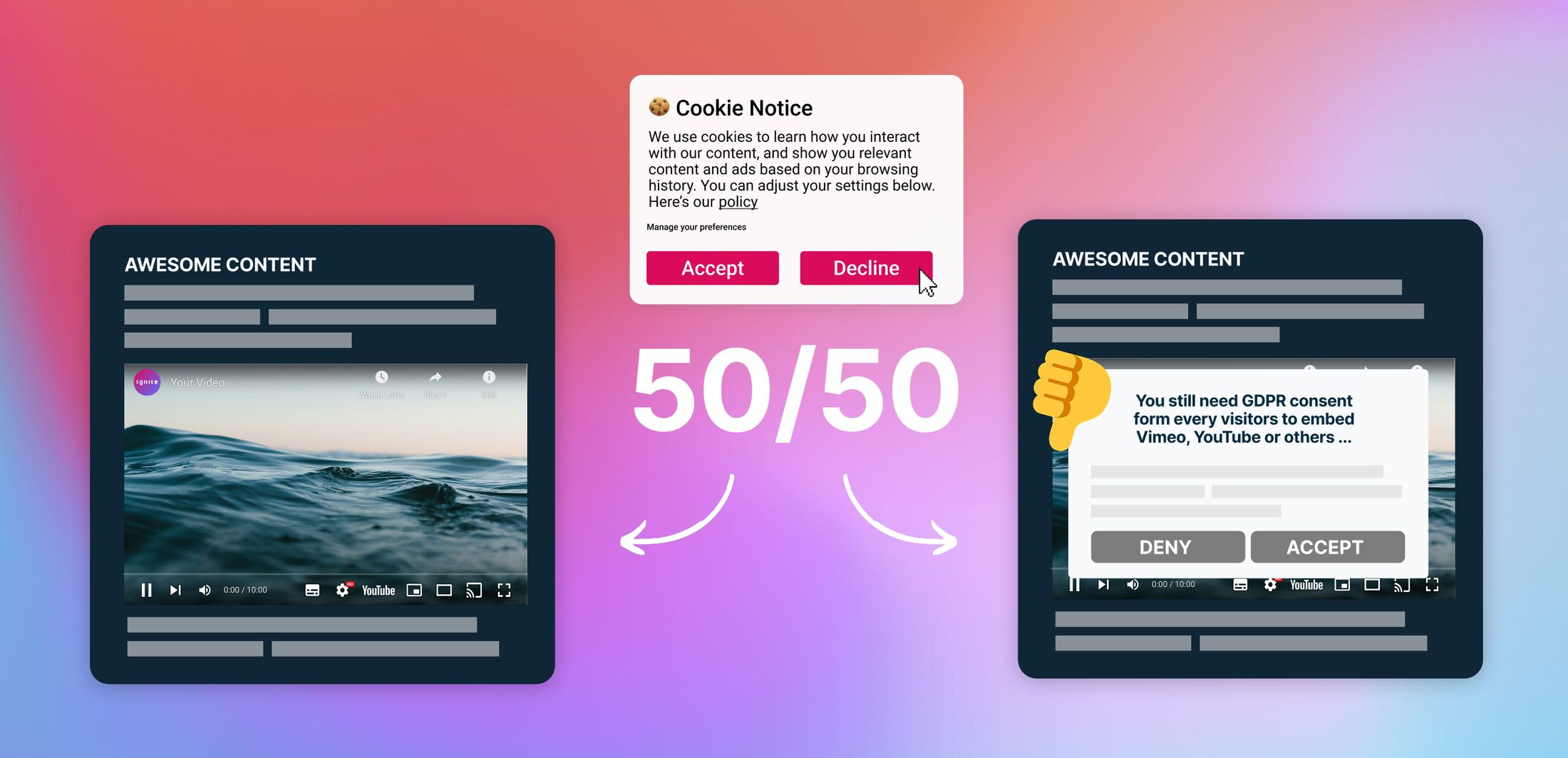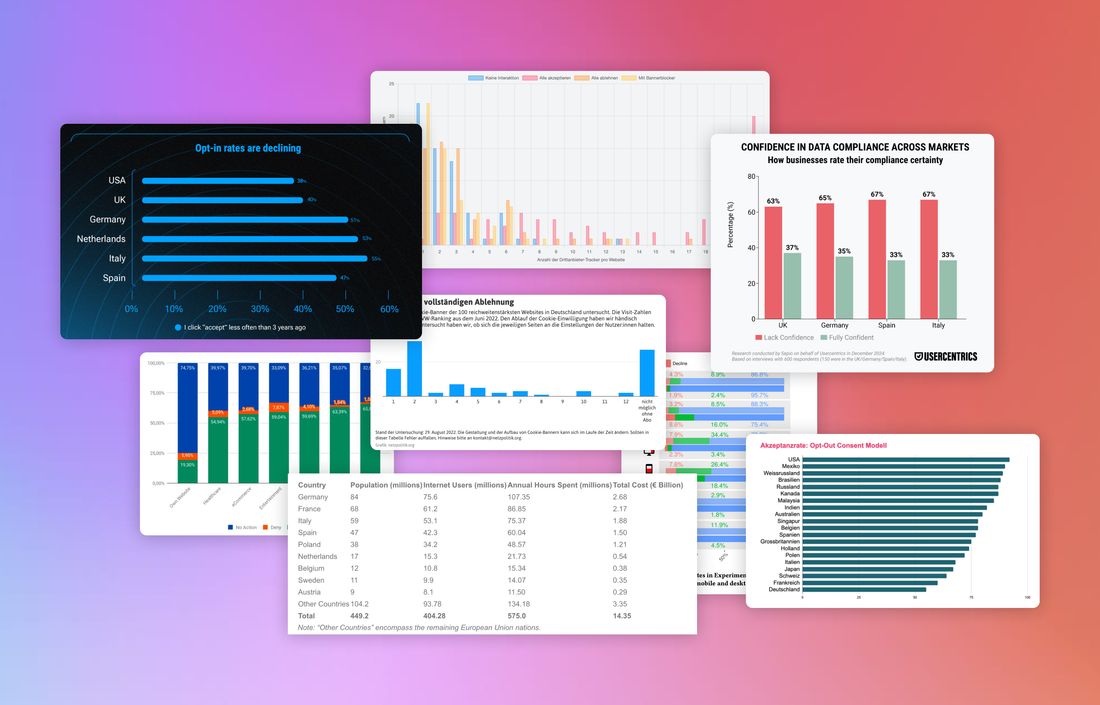
21 studies on cookie banners: Rejection rates, GDPR compliance & user behavior at a glance
Cookie banners have now become standard on almost every website. But how users actually deal with them, what acceptance and rejection rates look like, and how many banners are truly GDPR-compliant often remain unclear. To bring more transparency to this, we’ve gathered and analyzed the most important studies from recent years.
In total, we’ve compiled 21 studies that shed light on different aspects of cookie banners. Our focus was on the following questions:
- What are the acceptance and rejection rates for cookie banners?
- What role does design play (e.g., placement, dark patterns, button symmetry)?
- How have acceptance and rejection evolved over the years?
- How many cookie banners are actually GDPR-compliant?
- What are the consequences of rejected banners for website performance, content visibility, and data quality?
Current figures on cookie and consent banners, plus websites’ GDPR compliance — at a glance
Bottom line up front:
The numbers are clear. Users have no appetite for tracking. When they have a choice, 50–70% opt out. Still, many companies rig their banners so that “Reject” is hidden — and drive the rejection rate below 10%. Sometimes knowingly. Sometimes not. Users click “Accept” grudgingly. They feel pressured — and that feeling demonstrably erodes trust.
Compliant, fair banners aren’t a risk — they’re an advantage. They create transparency, strengthen brand trust, and show that you take your customers seriously.
What’s the rejection rate for cookie banners?
Depending on the design, the rejection rate sits at around 50% to over 60% when a clearly visible “Reject all” button is offered on equal footing. But if rejecting takes multiple clicks, up to 90% of users end up accepting instead (2024 / Study No. 05; 2023 / Study No. 03; 2024 / Study No. 04).
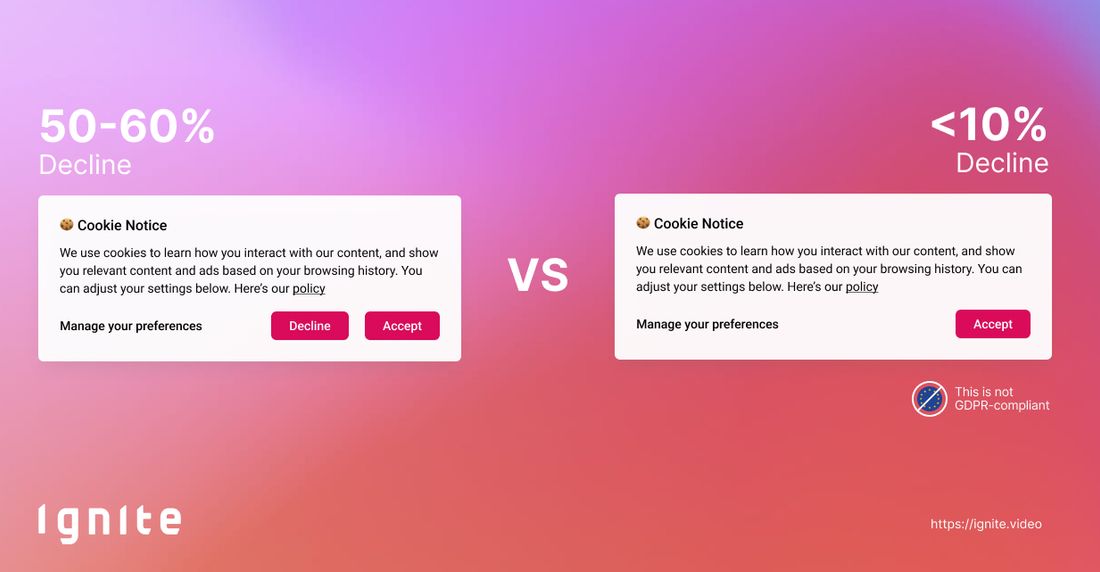
How have acceptance and rejection rates evolved over the years?
The trend is clear: Back in 2018–2019, the majority clicked “Accept all” (60–90%), often because there were no real reject options. From 2021–2023, regulation and public debate pushed rejection rates up to 40–50% whenever users had a visible choice. In the latest data from 2024–2025, about half to two-thirds now reject when a proper “Reject all” button is offered.
(2019 / Study No. 02; 2020 / Study No. 01; 2022 / Study No. 01; 2024 / Study No. 05; 2025 / Study No. 01).
How many websites offer a real “Reject all” option?
Depending on the study, the share of websites with an equally visible “Reject All” button ranges between 15% and 87%. There is very high variance depending on the study, country, and websites analyzed. The vast majority still hide the reject option on a second layer or do not offer it at all. In Germany, however, 52% of websites now provide an equally visible reject button.
(2025 / Study No. 03; 2025 / Study No. 04; 2024 / Study No. 05; 2022 / Study No. 03).
What mainly influences the decision to accept or reject?
Two factors stand out: the user’s intent when visiting a website, and the design of the banner. People who come with a clear goal — like making a purchase or getting quick access to content — are more likely to accept cookies, even if they have privacy concerns. At the same time, banner design has a major impact: when “Accept” and “Reject” are equally visible, rejection rates rise significantly.
(2021 / Study No. 01; 2023 / Study No. 03; 2024 / Study No. 04; 2024 / Study No. 05).
How many cookie banners are GDPR-compliant?
Research makes it clear: most websites do not follow the rules when it comes to cookie banners. One analysis of over 35,000 European websites found that 49% were in violation. An international study of 254,148 websites across 31 countries showed that only 15% of cookie banners even met the minimum requirements. Analyses of 20 million interactions with consent management platforms also revealed that over 50% of websites set cookies before users had made any choice at all.
(2019 / Study No. 01; 2022 / Study No. 04; 2023 / Study No. 02; 2025 / Study No. 03; 2024 / Study No. 05).
What are the consequences of rejected banners for website performance?
High rejection rates mean that much of the data needed for marketing and optimization is lost — studies report 40–70% fewer tracking data points when a real “Reject all” option is available. This directly impacts KPIs such as reach, audience profiling, and conversion.
Even more problematic: many users do consent, but only to unlock blocked content like videos or maps. Studies refer to this as “consent under duress” — acceptance under pressure. Users experience this as unfair and frustrating, which undermines trust in the website and brand.
It’s especially noticeable with content that is technically tied to consent (e.g., YouTube, Vimeo, Google Maps, social media widgets).
(2022 / Study No. 01; 2024 / Study No. 04; 2025 / Study No. 01)
All studies and analyses on cookies & consent
Here you’ll find the studies we’ve discovered so far — sorted by publication year, not by relevance or scope. If you know of newer ones, send them our way.
Our focus is on European research, though a few international studies are included. For detailed questions, please contact the respective authors directly.
Important: Acceptance or rejection rates can’t be calculated in a one-size-fits-all way. They depend heavily on
- the type of banner (sticky, overlay, …)
- the design and look & feel
As a rule of thumb: the more compliant and fair the banner, the higher the rejection rate — because it makes it especially easy for users to say “no.”
Quick disclaimer: we reviewed, analyzed, and summarized over 20 studies. We did this very carefully, but it was a lot of data. If you spot a transposed number anywhere, please let us know. Thanks.
Four studies published in 2025
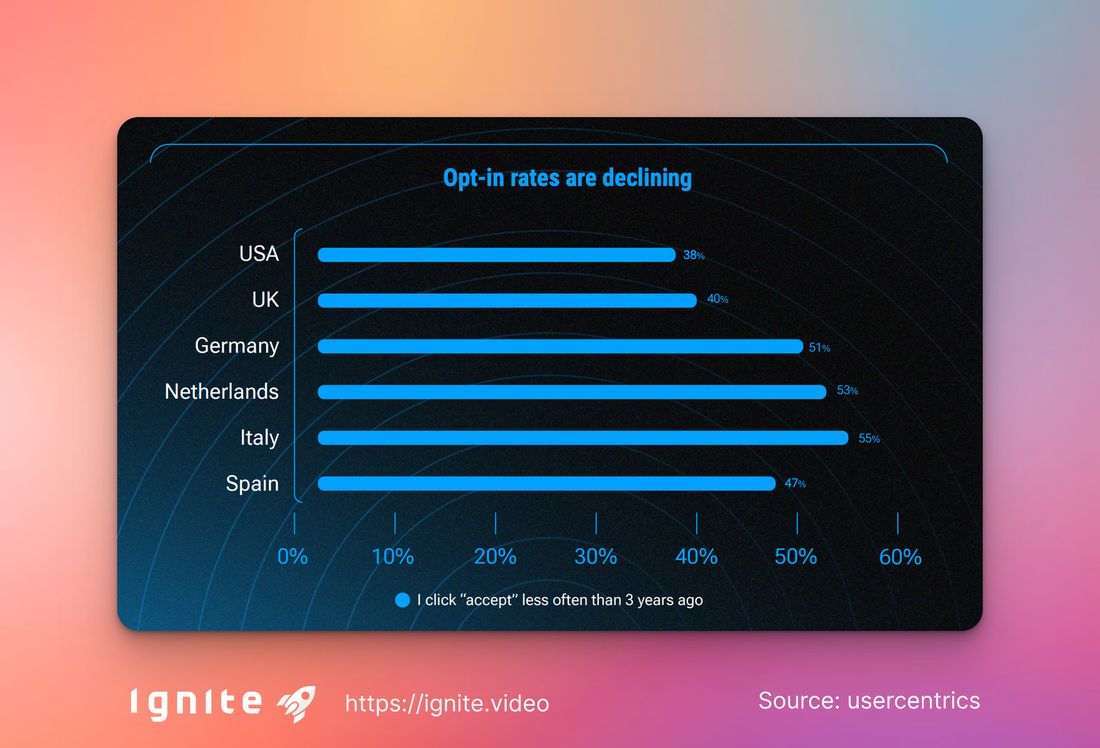
(2025 / Study No. 01)
46% click “Accept all” less often – consumers demand transparency
Subject of the study:
Perceptions of privacy, consent banners, and digital trust in the age of AI and Big Tech.
Scope:
Survey of 10,000 internet-savvy consumers in Europe (Germany, Italy, Spain, Netherlands, UK) and the US.
Key findings:
- 59% feel uncomfortable when their data is used to train AI.
- 48% trust AI less than humans when it comes to handling personal data.
- 42% “always” or “frequently” read cookie banners.
- 46% click “Accept all” less often today than three years ago.
- 36% have avoided websites or apps because of privacy concerns.
- 44% cite transparency in data use as a key trust factor.
- 77% don’t fully understand how brands collect and use their data.
Source:
Usercentrics / Sapio Research (May 2025) https://usercentrics.com/de/resources/state-of-digital-trust-report/
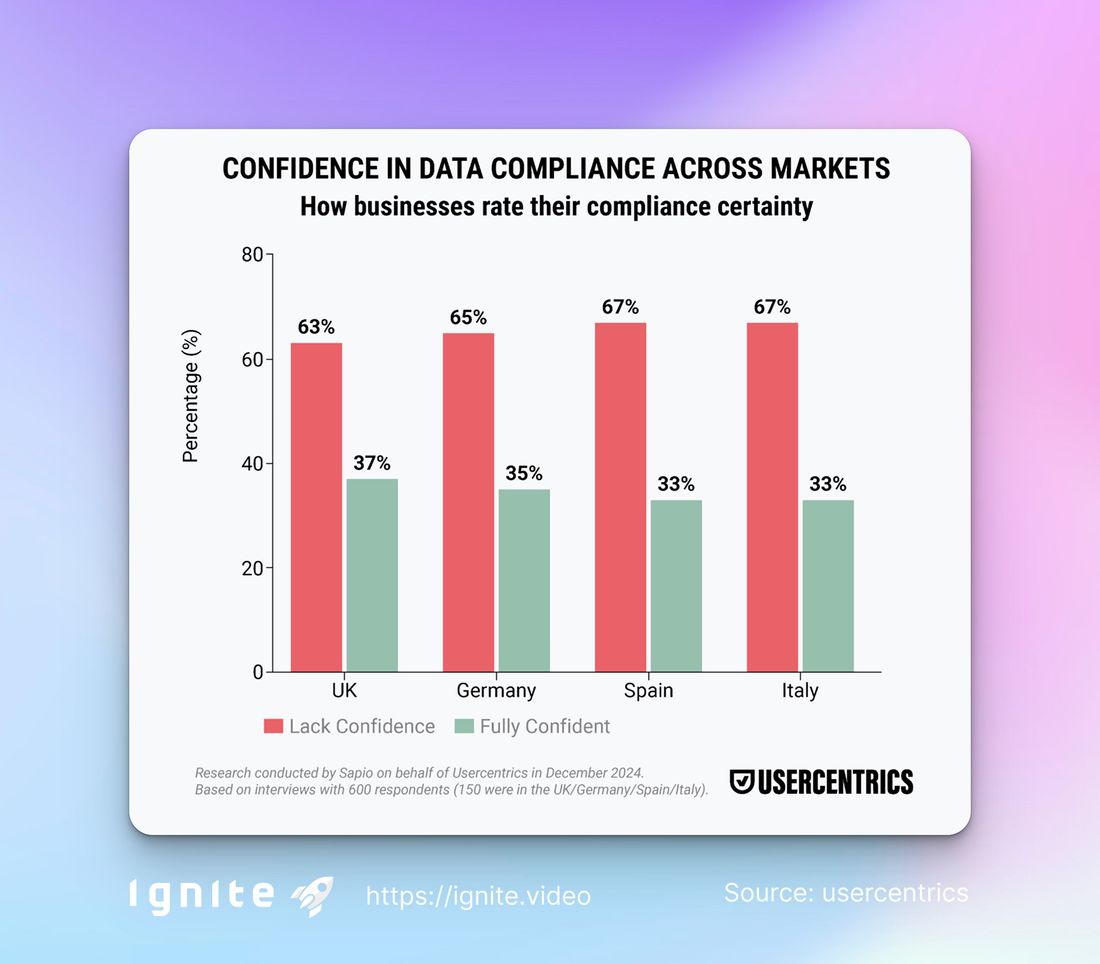
(2025 / Study No. 02)
Two-thirds of companies doubt their own GDPR compliance
Subject of the study:
Assessment by European companies of their compliance with data protection laws and cookie banner requirements.
Scope:
Survey of 600 decision-makers in the UK, Germany, Spain, and Italy (150 each).
Key findings:
- Only about one-third of companies are confident they fully meet the requirements.
- 41% of companies in Italy cite lack of resources as the biggest hurdle, while 43% in the UK want a larger compliance team.
- Customer trust is the main motivation, especially for small businesses.
- Large companies also emphasize the fear of reputational damage.
- 56% of companies manage data protection internally, while 44% use hybrid models (in-house plus external expertise).
Source:
Usercentrics / Sapio Research (Dec. 2024 – publication March 2025) https://usercentrics.com/press/usercentrics-research-european-businesses-doubt-their-data-compliance/
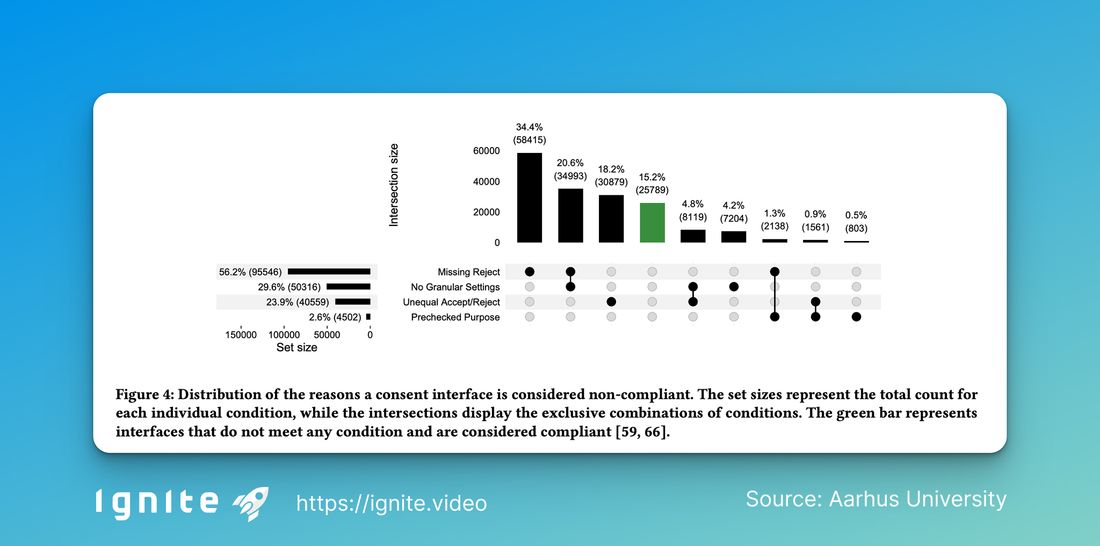
(2025 / Study No. 03)
Only 15% of cookie banners are GDPR-compliant
What was analyzed:
Large-scale study on the design, prevalence, and compliance of cookie banners in Europe.
Scope:
Analysis of 254,148 websites from the top 10,000 in 31 EU countries and the UK.
Key findings:
- 67% of websites use a consent banner.
- Only 15% meet the minimum requirements for GDPR compliance.
- 45% of banners offer a “Reject” option, but it is usually less prominent than “Accept.”
- 67% of banners come from consent management platforms (CMPs). Market leaders include Usercentrics, CookieYes, and OneTrust.
"Caught up in the narrative that better interfaces are the answer, we risk losing sight of the fact that disempowerment is not a design flaw, but an inherent feature. The law does not require it–consent in EU law is a last-resort when no other legal basis can be established, not an important prerequisite. Because online tracking cannot be legalised in any other way in Europe, the industry response to a de facto legal prohibition has been to use design to stretch consent to and beyond its conceptual limits."
Source:
A Cross-Country Analysis of GDPR Cookie Banners (2025, Aarhus University)
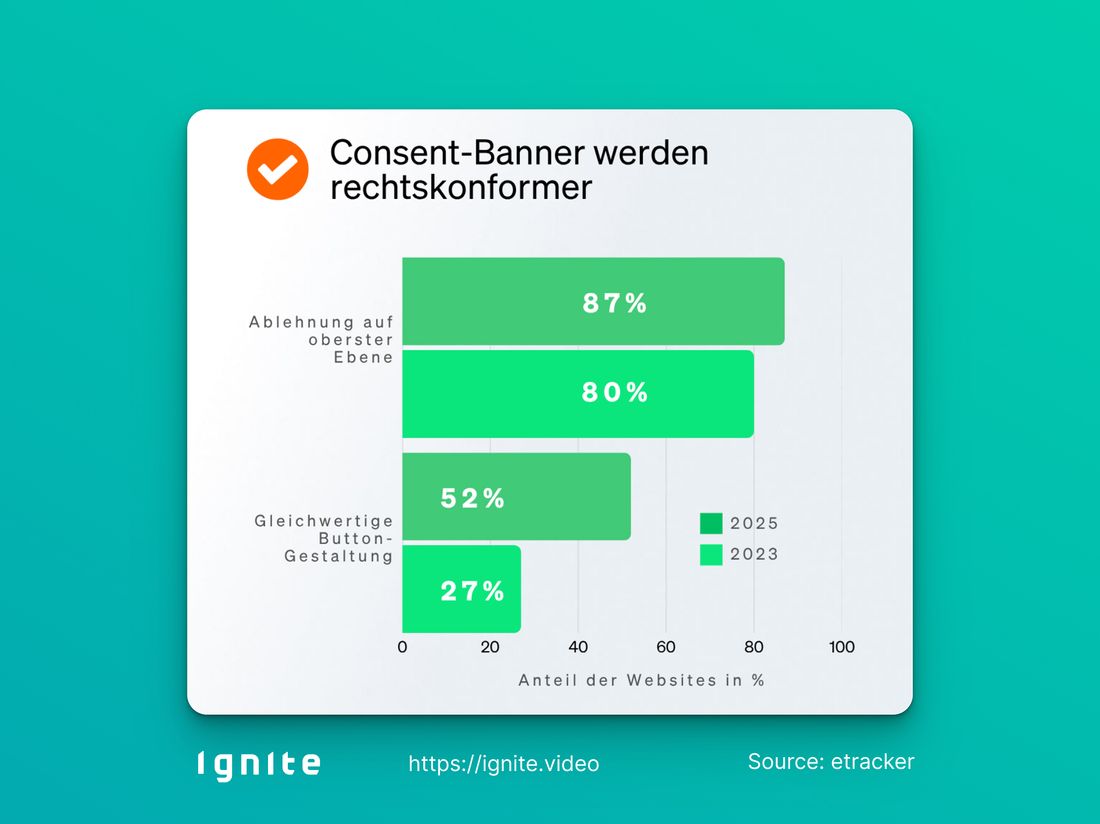
(2025 / Study No. 4)
Share of equally visible Accept/Reject buttons in Germany rises from 27% to 52%
Subject of the study:
Analysis of consent rates and legal compliance of cookie banners.
Sample:
500 German websites with consent banners, data up to May 2025.
Key findings:
- The share of websites with equally visible “Accept”/“Reject” buttons increased from 27% (2023) to 52% (2025).
- The average consent rate in Germany ranges from 40% (with an equally visible reject button) up to 54%.
- Industry effects: Real estate and energy websites recorded the lowest consent rates, while banks and insurance companies even achieved higher rates with compliant designs.
- No differences between desktop and mobile (~50% consent rate).
- Strong differences by traffic source: Users coming from DuckDuckGo rejected much more often, while referrals from Facebook or Google led to significantly higher consent rates.
Source:
etracker (2025), Consent Benchmark Report 2025 https://www.etracker.com/app/uploads/2025/07/etracker-Consent-Benchmark-2025.pdf (GERMAN!)
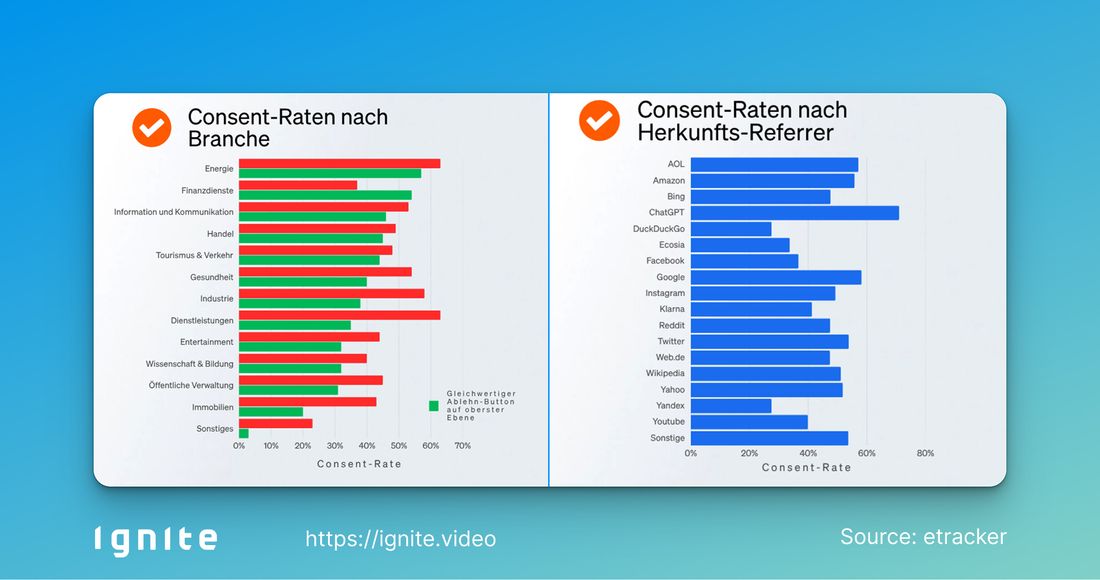
5 studies published in 2024
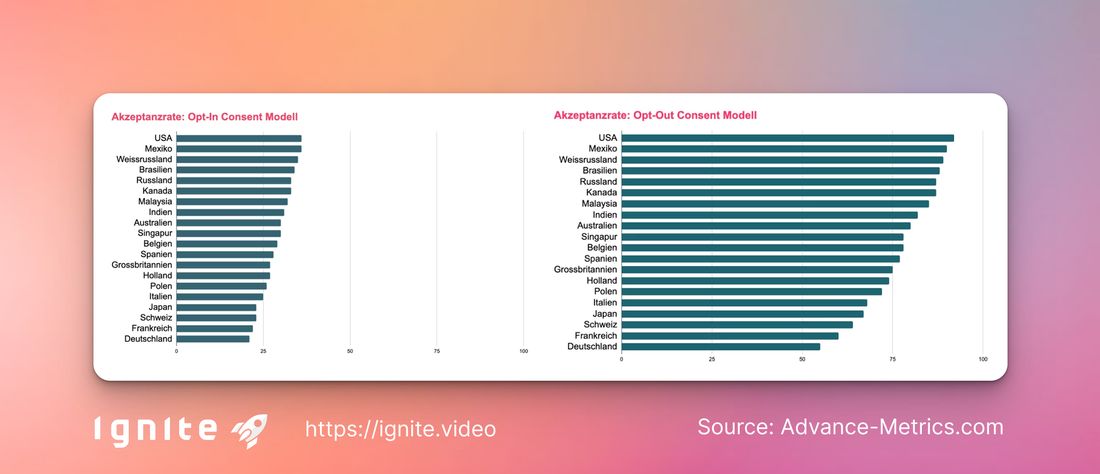
(2024 / Study No. 01)
Nearly 70% close or ignore cookie banners — and therefore don’t give consent
Subject of the study:
Changes in user behavior with cookie banners between 2018 and 2023.
Scope:
Analysis of over 1.2 million user interactions on international B2B websites (services, industry, trade).
Key findings:
- 25.4% accept all cookies directly on the first level of the banner.
- Only 0.4% open the cookie settings (second level).
- In total, 68.9% of banners are closed or ignored — which does not provide consent and leads to significant data loss for marketing measurement.
Country comparison:
- Rejection rates are highest in Germany and France.
- In the US, cookies are most likely to be accepted.
- Opt-in vs. opt-out: Countries with opt-out models (e.g., Malaysia, Belarus) show significantly higher acceptance rates, since ignoring automatically counts as consent.
Source:
Advance Metrics, Cookie-Banner-Stury (2024, Comparison 2018–2023) https://www.advance-metrics.com/de/blog/cookie-banner-verhaltensstudie/
(2024 / Study No. 02)
Study: Majority of Germans annoyed by cookie banners
Subject of the study:
Attitudes and frustration levels of German internet users toward cookie banners and tracking notices.
Scope:
Representative survey of 1,013 participants aged 16 and above in Germany.
Key findings:
- 76% find cookie banners annoying.
- 68% don’t want to deal with cookie settings.
- 51% avoid websites because they set too many cookies.
- 58% regularly delete their cookies.
- 34% consider the settings important, but 31% admit: “I don’t understand this.”
- 24% agree to all cookies because they “can’t be bothered” with the settings.
- 21% accept all cookies in order to use additional features.
- 21% reject everything that can be rejected.
- 33% selectively choose which cookies/tracking to allow.
Source:
https://bitkom-research.de/news/drei-viertel-sind-von-cookie-bannern-genervt
(2024 / Study No. 03)
Study: Cookie banner tools show contradictory effects on privacy
What was studied:
Technical analysis of browser tools that automatically interact with cookie banners (I don’t care about cookies, Consent-O-Matic, Ninja Cookie, SuperAgent, CookieBlock). Goal: to assess how these tools affect user privacy and GDPR compliance.
Scope:
Tests with 9 browser profiles across tens of thousands of websites. Measurements focused on the impact of the tools on cookies set, HTTP requests, and tracking behavior.
Key findings:
- The tools behave very differently: some significantly reduce tracking cookies (e.g., CookieBlock), while others actually lead to more cookies or additional HTTP requests.
- GDPR compliance is not guaranteed for many tools — in some cases, consent is automatically granted or denied without informing users.
- The results paint a fragmented picture: while automation saves clicks, it also creates legal uncertainty and unclear privacy outcomes.
Source: https://petsymposium.org/popets/2024/popets-2024-0002.php
(2024 / Study No. 04)
Banner design doubles or halves the rejection rate
Subject of the study:
Impact of different cookie banner designs (dark patterns vs. transparent “bright patterns”) on user acceptance and rejection.
Scope:
Online experiment with 3,947 participants in France.
Key findings:
- Neutrally designed banners led to only 17% rejections — well below the actual privacy preferences (~31%).
- A “no decline” banner pushed the rejection rate down to 4%.
- A banner with an equally visible rejection option increased rejection to 34%.
- 50% of participants said they accept cookies out of habit — not because they actually wanted to.
- The “consequences” banner, which explicitly highlighted tracking, reached the highest rejection rate at 47%.
- Manipulative designs systematically suppress rejection, while transparent banners significantly increase it.
- However, transparent, compliant banners are not a risk but a trust factor: users rated them as fair twice as often compared to manipulative designs.
Source:
Bielova et al., USENIX Security Symposium (2024, in Cooperation with CNIL) https://www.usenix.org/conference/usenixsecurity24/presentation/bielova
(2024 / Study No. 05)
Over 60% of websites with CMPs still set trackers before consent. Around 60% reject cookies when a “Reject all” button is available.
Subject of the study:
Development of consent management platforms (CMPs) in Europe, their prevalence, and their compliance with GDPR.
Scope:
Long-term analysis of websites between 2015 and 2023, focusing on EU domains.
Key findings:
- Before GDPR, around 5% of websites used a CMP; by the end of 2023, it was 42%.
- Over 60% of websites with a CMP still set trackers before users had given consent.
- When a “Reject all” button is available on the first layer, about 60% of users reject.
- If rejecting requires more than one click, however, around 90% accept.
- iOS users are more likely to accept cookies than Android users.
"For instance, over 60% of users do not consent when offered a simple “one-click reject-all” option. Conversely, when opting out requires more than one click, about 90% of users prefer to simply give their consent. The main objective is in fact to eliminate the annoying privacy banner rather the make an informed decision."
Source:
Longitudinal Analysis of Consent Management Platforms in the EU (2015–2023, Published 2024)
4 studies published in 2023
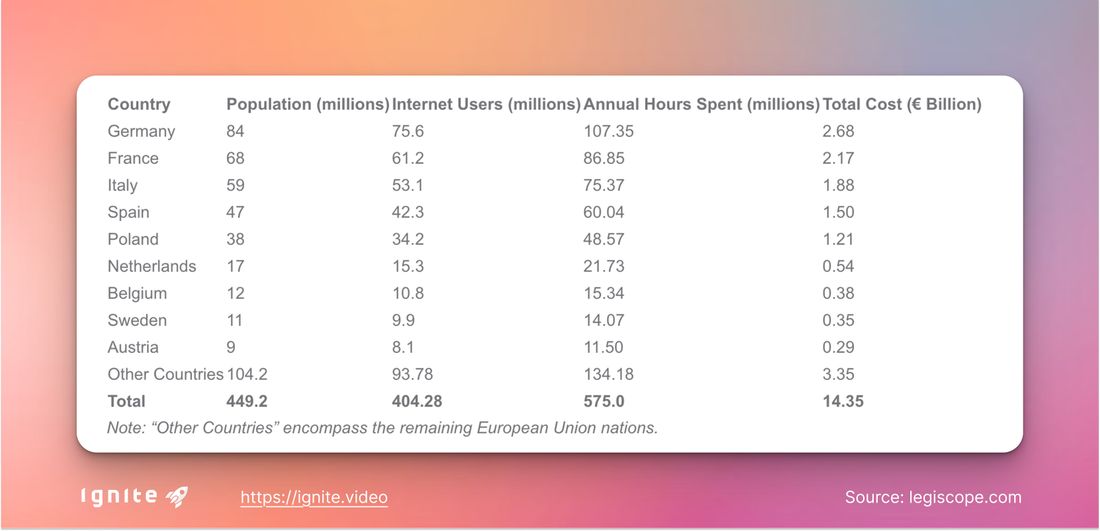
(2023 / Study No. 01)
Study: Europeans spend 575 million hours per year on cookie banners
What was studied:
How much time European internet users waste each year on cookie banners — and the resulting productivity losses.
Scope:
Analysis of user interactions in several European countries.
Key findings:
- A total of 575 million hours per year are spent dealing with cookie banners.
- The privacy benefit of these clicks is minimal, while the productivity losses are enormous.
- Constant confrontation with consent prompts lowers user satisfaction and undermines trust in online platforms.
Source: https://legiscope.com/blog/hidden-productivity-drain-cookie-banners.html
(2023 / Study No. 02)
Study: European websites show higher GDPR compliance than US sites
Subject of the study:
Geographical differences and user interactions with cookie banners on the world’s most visited websites.
Scope:
Analysis of the global top 10,000 websites.
Key findings:
- European websites are significantly more likely to use GDPR-compliant cookie banners.
- In 58% of cases, however, trackers are still loaded before consent is given.
- The design and effectiveness of banners vary greatly by region.
- US websites make significantly more frequent use of manipulative design patterns (“dark patterns”) compared to European ones.
Source:
Exploring the Cookieverse: A Multi-Perspective Analysis of Web Cookies (2023)
(2023 / Study No. 03)
Study: Clear opt-out options increase user trust
Subject of the study:
Psychological and technical evaluation of how different banner designs (neutral, dark patterns, bright patterns) influence user decisions.
Scope:
Online experiment with 4,000 adults in France.
Key findings:
- 93% of respondents consider privacy a priority, but only a few actively pay attention to cookie settings.
- With neutral banners, only 16% rejected cookies.
- With clear and transparent “bright pattern” banners, the rejection rate rose to 33–46% — close to the originally stated preferences (31–48%).
- Dark patterns drastically lowered the rejection rate (in some cases, only 4% rejected).
Source:
La DITP & CNIL: Impact of Cookie Banner Design (2023)https://www.modernisation.gouv.fr/publications/la-ditp-mesure-limpact-du-design-des-bannieres-cookies-sur-les-internautes
(2023 / Study No. 04)
Study: News sites most frequently use accept-or-pay banners
What was studied:
How widespread are cookie banners that force users to choose: either accept cookies or pay for ad-free access?
Scope:
Analysis of around 45,000 websites worldwide, with a focus on news outlets and content portals.
Key findings:
- 0.6% of all websites studied use accept-or-pay banners.
- In Germany, the share is significantly higher: 2.9% of the top 10k websites.
- News sites are among the most frequent adopters.
- Websites with cookie walls set on average 6.4 times more third-party cookies and 42 times more tracking cookies than sites using standard banners.
Quelle:
https://arxiv.org/abs/2310.01108
8 studies from 2022 or earlier
(2022 / Study No. 01)
Study: Decline of third-party cookies on French websites (CNIL, 2022)
Subject of the study:
Long-term analysis of cookie practices on French websites — especially regarding third-party tracking and the effects of CNIL enforcement measures.
Scope:
Monitoring of the 1,000 most visited French websites between January 2021 and August 2022 using the CookieViz tool from CNIL’s Digital Innovation Laboratory (LINC). The study examined the use of third-party cookies before any user interaction.
Key findings:
- The share of websites setting more than six third-party cookies dropped from 24% to 12% during the period studied.
- At the same time, the share of websites without any third-party cookies rose from 20% to 29%.
- These figures point to a significant reduction in tracking activity — at least before any explicit user consent.
Limitation:
The study does not assess GDPR compliance of banners or consent design, but only the technical practice (cookie usage) at first visit.
Source:
(2022 / Study No. 02)
Every second person doesn’t want cookies anymore (2022)
Subject of the study:
Attitudes of internet users in Germany toward cookies and cookie banners.
Scope:
Representative survey of 1,001 people aged 18 to 69 (Nov. 2022).
Key findings:
- 50.1% would prefer to abolish cookie banners and “just do things the old way.”
- 30.4% think cookie banners are good and want to keep them.
- 47.2% actively adjust cookie settings and allow only technically necessary cookies.
- 43.7% regularly delete cookies.
- Higher education correlates with stronger resistance to data collection.
Source:
Net.ID / INNOFACT-Studie (2022) https://www.horizont.net/medien/nachrichten/studie-der-net.id-so-viele-internet-user-stoeren-sich-an-cookies--oder-an-den-cookie-zustimmungsbannern-204514 (paywall)
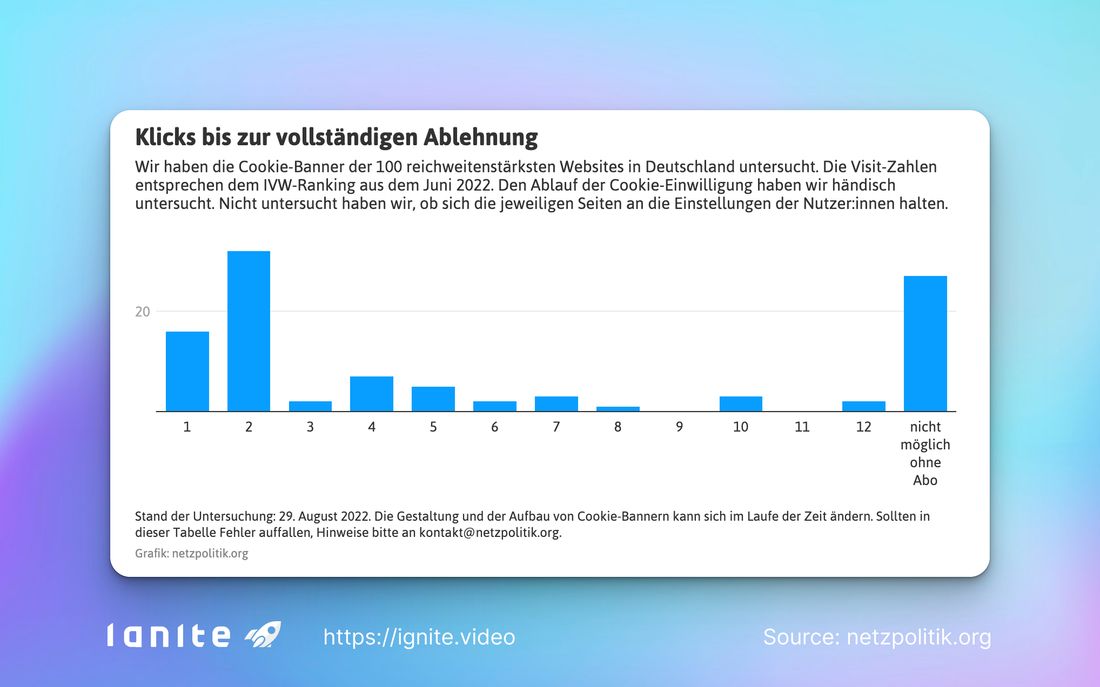
(2022 / Study No. 03)
Study: Manipulative cookie banners on almost 80% of top websites (netzpolitik.org, 2022)
Subject of the study:
Design and user-friendliness of cookie banners on the 100 most visited websites in Germany.
Scope:
Systematic review based on the IVW ranking, August 2022.
Key findings:
- 77% deliberately use manipulative designs (“dark patterns”), e.g. through color highlights that make acceptance more likely.
- Only 4% provide a “Reject all” option on equal footing with “Accept all” directly in the first dialog window.
- On nearly half of the sites, it takes 2–5 clicks to reject all optional cookies — even though a one-click solution would be technically possible.
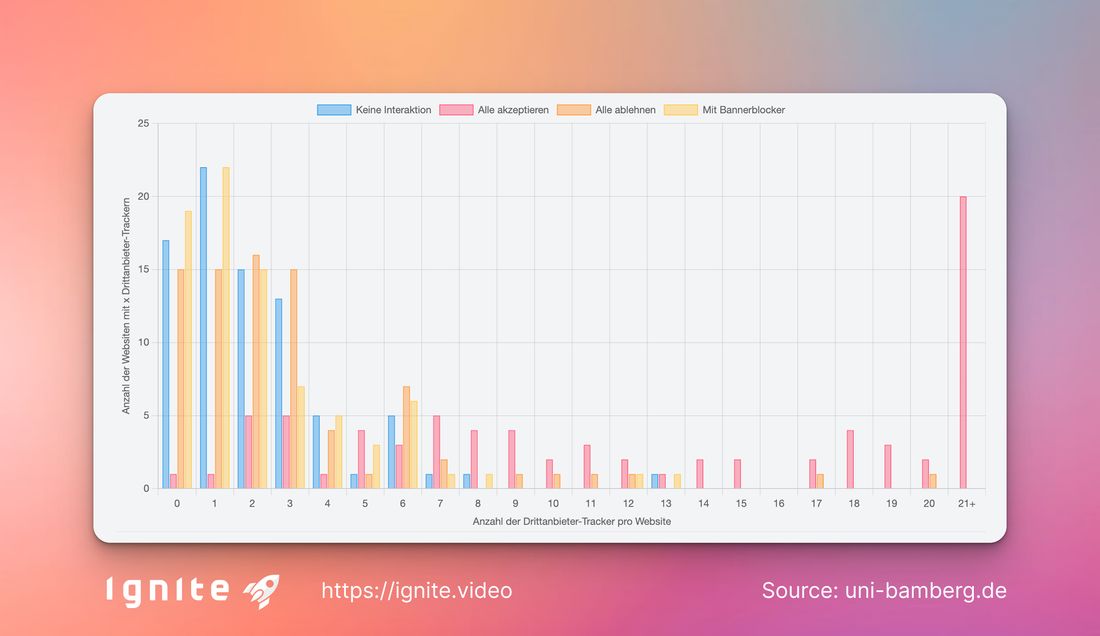
(2022 / Study No. 04)
73% of websites load third-party trackers before consent (2022)
Subject of the study:
Technical effectiveness of cookie banners on German-language websites and their GDPR compliance.
Scope:
Analysis of 81 websites with cookie banners (from a random sample of 100 German domains).
Key findings:
- 79% of the websites studied (64 out of 81) already load third-party trackers before users interact with the cookie banner at all.
- On average, 3 trackers are active at that point — with up to 13 on some sites.
- Even when users actively reject (“Reject all”), an average of 4 trackers are still loaded.
- Only 17% of sites consistently block tracking until consent is given.
- Clicking “Accept all” activates an average of 18 trackers — with peaks of up to 63.
Source:
Tracker-Scan-Studie, University Bamberg (2022)
(2021 / Study No. 01)
Cookie decisions depend mainly on why someone visits a website – and hardly at all on brand trust or privacy knowledge (2021)
Subject of the study:
Psychological and design factors influencing cookie decisions in the EU.
Scope:
Online survey with 132 EU users.
Key findings:
- User intent is the most important factor: those visiting a website with a clear goal are more likely to accept cookies, even if they have privacy concerns.
- Awareness alone rarely leads to rejection: knowledge of risks doesn’t automatically translate into behavior.
- Design matters: clear opt-out options increase rejection, manipulative designs boost acceptance.
- Brand trust has surprisingly little impact on cookie decisions.
- Most find banners annoying, but still want real choices — 88% expect at least one opt-out option.
Source:
Cookies ’n’ Consent: An Empirical Study on the Factors Influencing Website Users’ Attitudes towards Cookie Consent in the EU (2021)
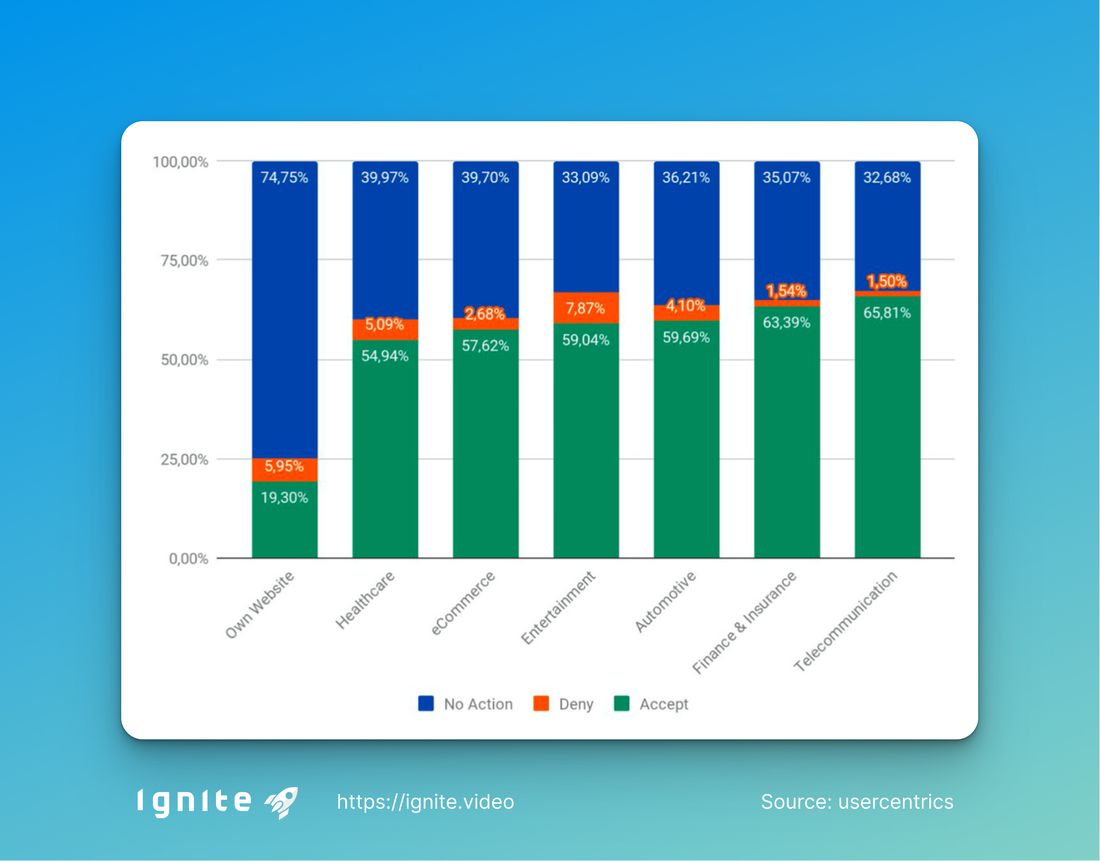
(2020 / Study No. 01)
Study: 30–75% acceptance rate in e-commerce. Rates vary widely across industries (2020)
What was studied:
Cookie acceptance rates across different industries — and what this means for data-driven marketing.
Scope:
Analysis of websites from various sectors, based on data from Usercentrics.
Key findings:
- In e-commerce, acceptance rates range from 30% to 75%, with an average of 58%.
- On B2B websites, rates are usually around 80% but can drop as low as 40%.
Note: Most websites today no longer allow users to simply not interact. “No action” is hardly an option anymore.
Quelle: https://www.verdure.de/magazin/technologie/cookies-akzeptanzrate-consent-marketing-zustimmung/
(2019 / Study No. 01)
54% of websites violate GDPR (2019)
What was analyzed:
Examination of whether cookie banners using the IAB Europe Transparency & Consent Framework (TCF) actually respect user choices and comply with the law.
Scope:
Analysis of 1,426 websites with TCF banners (out of a total of 22,949 crawled European websites). Detailed legal and technical review for GDPR and ePrivacy violations.
Key findings:
- 54% of the websites examined (304 out of 560 closely reviewed) showed at least one suspected GDPR or ePrivacy violation.
- 47% of banners used pre-checked options, leading to invalid consent.
- 7% of websites offered no way to reject at all.
- 10% of websites stored a positive consent before users had even made a choice.
- 5% of websites stored consent despite an explicit rejection.
Quelle: https://arxiv.org/abs/1911.09964
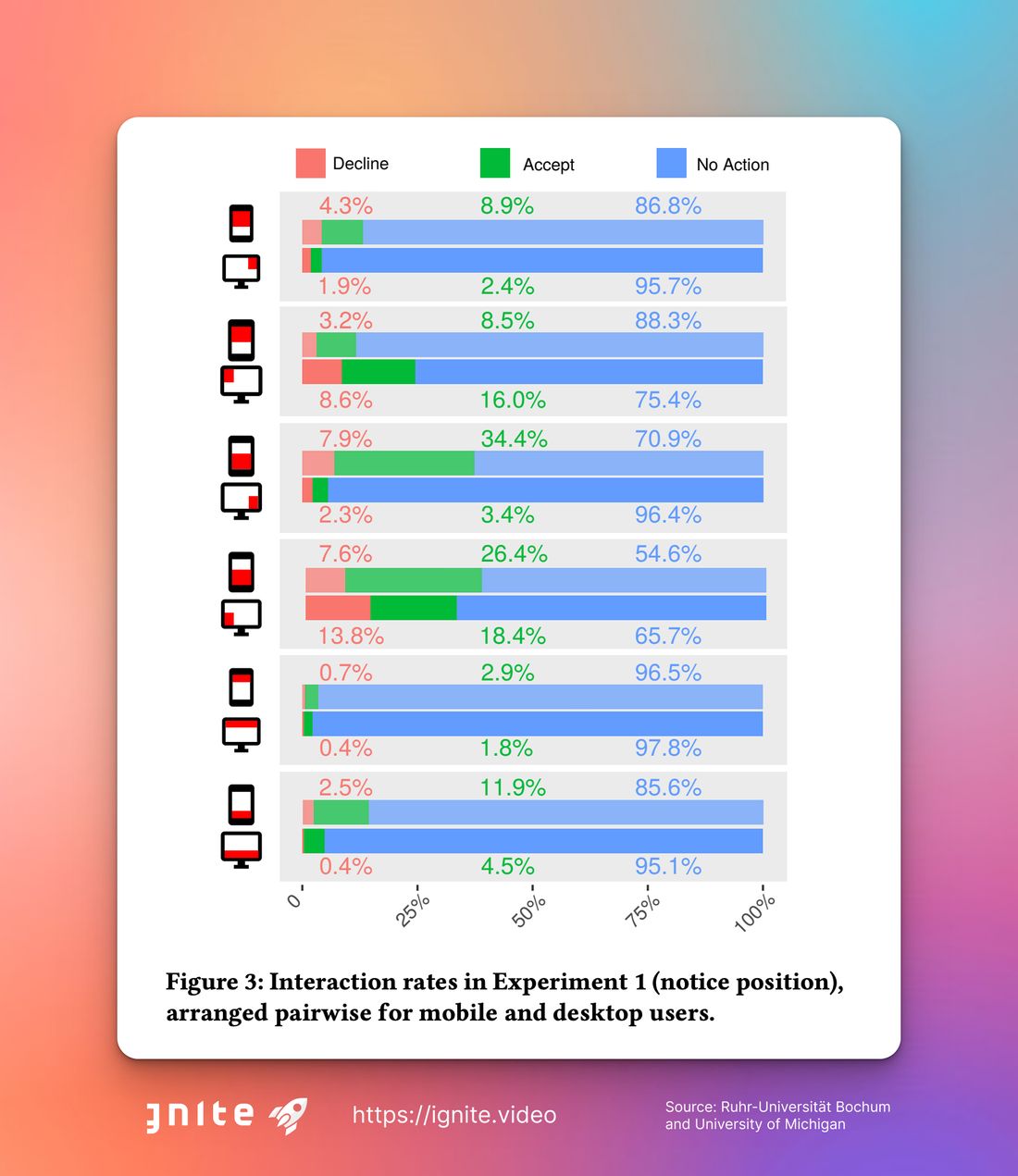
(2019 / Study No. 02)
Dark patterns increase acceptance by up to 80 percentage points (2019)
Subject of the study:
Impact of banner design (position, wording, nudging, preselection) on cookie decisions.
Scope:
Three field experiments with over 80,000 real website visitors on a German e-commerce site.
Key findings:
- Banners placed at the top led to significantly more interactions than banners at the bottom.
- Without nudging, fewer than 0.1% of users gave consent for all purposes.
- With preselected checkboxes, acceptance rates rose to 81–83%.
- Manipulative wording (“We respect your privacy”) increased acceptance only slightly compared to neutral wording.
- Granular choice options lowered acceptance and significantly increased rejections.
- Overall, 57% of visitors interacted with the banner; with fair opt-out options, up to 45% used the rejection option.
Source:
Study of the Ruhr-Universität Bochum and the University of Michigan (2019) https://dl.acm.org/doi/10.1145/3319535.3354212
The GDPR Illusion of Vimeo, YouTube & Co: Why Your Videos Often Go Unseen.
Everyone claims to be GDPR compliant. Of course. But all this really means is you need your visitors' consent. In practice, you integrate the video provider into your consent management platform, and your visitors may agree via the cookie banner. The catch? Depending on the website and the effectiveness of the cookie banner, only 30-60% of visitors consent . For the rest, all video content must either be removed by the provider or hidden behind a so-called "two-click solution."
Put simply: every other visitor doesn’t see your video.
You're looking for a solution that delivers your videos to all visitors while being more than GDPR-compliant: cookie and consent free, like Ignite Video.
